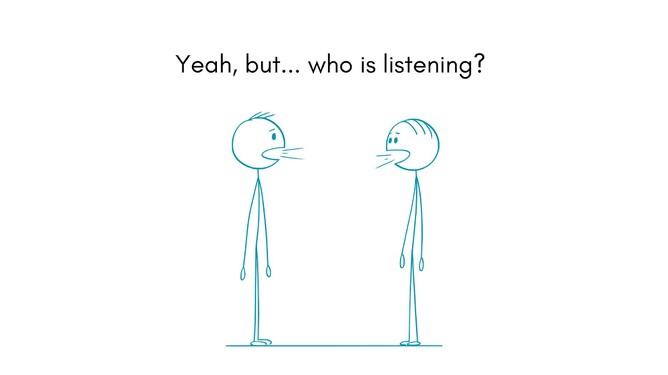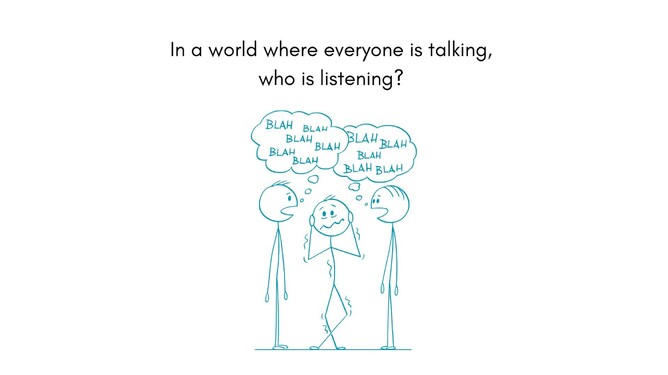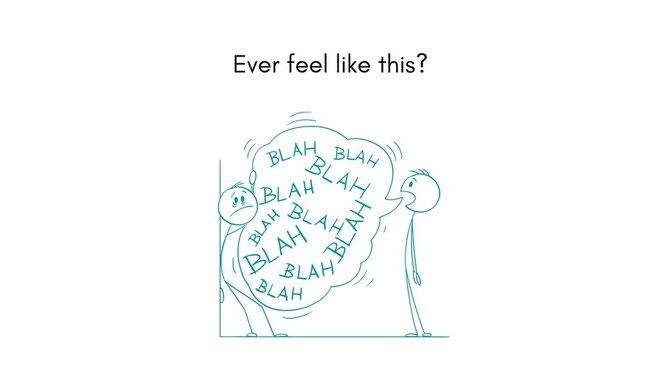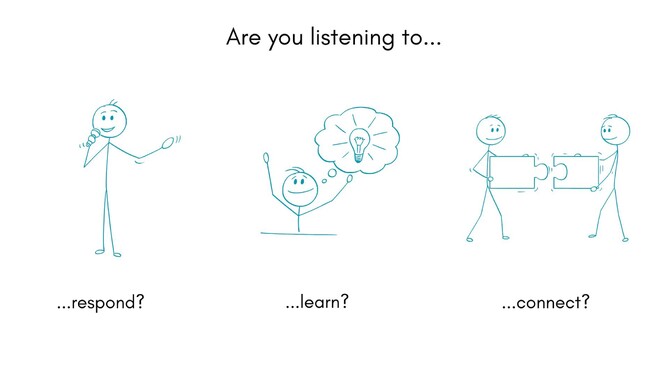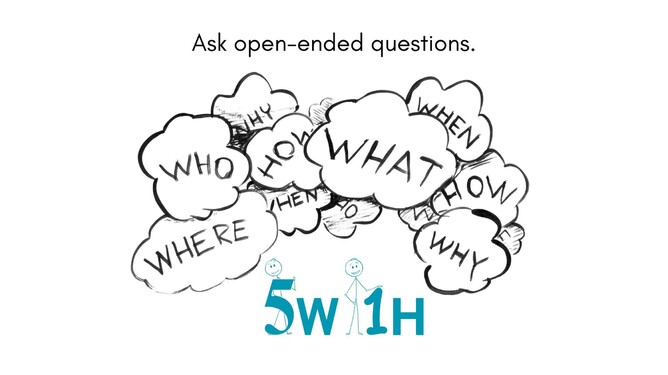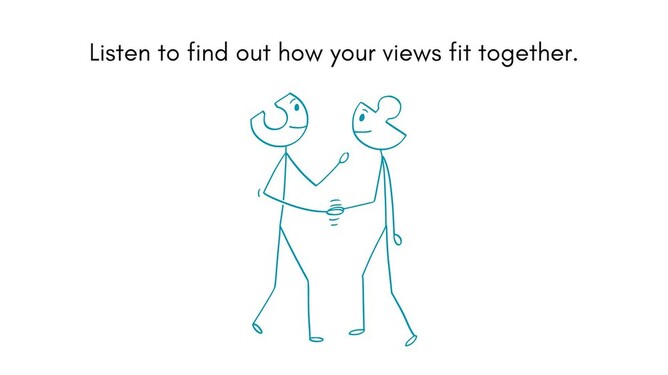Sometimes I find myself talking to someone and after a few moments, I can tell they are not listening; they are somewhere else with their thoughts. Maybe their eyes have glazed over a bit. They are not really here. And then, other times, I find myself listening to someone, and after a few moments (or minutes), I realise, I am not taking in what they are saying. I’m someplace else with my thoughts.
Listening comes up often in conversations with clients and athletes: how to do it, how it feels to be listened to, and how it feels not to be listened to. And often we get to a point where one of us observes that we place more importance on speaking than on listening and that we have created (anti-) social media that are all about sharing and talking rather than listening to each other.
So, in a world that can’t stop talking, who is actually listening?
As it turns out, listening is a skill. And listening, like really listening, is quite difficult.
There are two different skills that I want to touch on today. The first one, surprise, surprise, is the listening itself. So let’s start there:
Listening to what people are saying, and what information they are sharing, goes well beyond simply hearing and processing the sound they are making. Though those are important too.
Different people have categorised listening differently. A quick Google search reveals, that there is a range from three all the way up to nine different kinds of listening. You can go for a deep dive on this online if you like. There are also whole books written on this topic, so your nearest library or bookstore is your friend.
For ease, I’ll go with three different kinds of listening today:
listening to respond
listening to learn and
listening to connect (or empathetic listening).
So, let’s start with listening to respond. This is fairly straightforward and also fairly annoying, particularly if you are at the receiving end of it. When we are listening to respond, we typically look somewhat interested, we might nod along in agreement, but really we are just waiting for the other person to pause or take a breath for long enough to jump in and share our own story. You might be telling someone about your holiday at the beach and just as you get into it, they jump in and tell you about the time they were at the beach, what happened there, who they were with, and so on. No one asked. And you now don’t feel like sharing the rest of your story.
At times, people who listen to respond also offer unsolicited advice. ‘Oh, you are going to London? You should go to this café and that restaurant.’ Ok, thanks, I didn’t ask. It gets particularly entertaining when you have two people who listen to respond because, basically, they will both be trying to share their stories, views, perspectives, experiences and advice. Often it becomes a trade of sentences that start with ‘I’: ‘I went to…’, ‘Oh really, well I have a…’, ‘But I think that…’ and so on.
Neither of them will feel heard at the end. Both of them may as well have had a conversation with a tree. At least they would have had the benefit of being in nature… I call this trading an ‘I’ for an ‘I’...
I probably don’t need to (or want to) explain in detail how listening to respond works… I feel like we have enough of that around already. But if you are trying to recognise it in your life or when doing it yourself, here are some of the things to look out for: jumping in whenever the other person is taking a breath, starting responses either with ‘I’ or with ‘Yeah, but…’ and only sharing what you want to say without any reference or connection to what has been raised by others. All these are outwardly noticeable. However, if you are trying to catch yourself before you do this, notice whether you are getting ready to respond while the other person is still talking. Are you formulating or pre-planning a response in your head while they are still speaking? Are you thinking about what you will say next? If you are, you are not listening as actively and empathetically as possible.
Listening to learn is a bit different. Here, the listener tries to find factual information about events or details about a situation or a product. They might ask detailed questions about that specific item, event or situation, but show little interest in the speaker, the person sharing the detail. This can be useful and there are particular environments or circumstances when this type of listening is the most useful, when asking for directions for example. You don’t really need the full life story of the random stranger in the street but you need to listen to the information they share.
The same is true in many professional contexts, e.g. when clarifying details around a project or a product to be designed. Athletes and coaches often need to clarify details around training plans and training session focus to ensure everyone is on the same page. Similarly, you listen to announcements at the airport to get the information you need, not to get to know the speaker. This type of listening has its place. It is important that we can extract relevant information from what others are saying.
Listening to learn is relatively simple to do. You might have a few questions in mind already. You might ask those questions out loud too, if the person hasn’t already touched on them. You can notice yourself losing interest once you have the information you need or discover that the person you are talking to does not have the info you want. This one does not feel quite as frustrating for the speaker, because you still show a level of interest. And, depending on the context, this level of interest may be perfectly appropriate.
Listening to connect is the most holistic approach to listening. I also find it to be the most rewarding one both as a listener and when I am speaking and someone else is listening. Here you listen deeply to connect with the person. You also pay close attention beyond their words. You notice their eye contact (or the lack of it), body language, tone and volume. As you listen, you consider any background knowledge you have about the person. You also take into account their situation and how they might be feeling right now, as well as what their experience of what they are talking about would have been like given the person they are. This type of listening is the closest to trying to stand in someone else’s shoes.
Listening to connect is in my view the most rewarding experience for both the speaker and the listener. You are interested in what they say, who they are as a person or a professional, how they have come to the view or perspective they hold, etc. You also ‘listen’ to their tone, body language, gestures and eye contact much more closely than with the other two types of listening.
This type of listening is instrumental in forming strong relationships with the key people in your life. Your spouse, your kids, your parents, your family, your colleagues, your leaders, your coaches, and so on. But, it can be difficult to do sometimes. Particularly if you have a strong view on something and the other person does too, except they don’t agree with you. This can easily lead to you both slipping into listening to respond, just talking at each other and not getting anywhere. Sometimes people disagree so strongly that they stop talking to each other entirely, even when they are close friends or family. It feels to me that we have become less tolerant of different opinions. So I’d encourage you to keep talking, to seek to understand (Within reason obviously. It is good to have boundaries, and sometimes ending a friendship or relationship is the best way forward. But it doesn’t have to be the first step.).
There is a simple trick, a simple strategy, that you can try if you find yourself in a situation like this where you feel like you are unable to listen or when you strongly disagree with someone’s view.
This comes down to a mindset, an attitude, an approach, an intention - call it whatever you like. Pick the word that you find the least cringe-worthy. For me, that is ‘intention’. So when you next enter a conversation with someone with opposing views or with whom you find yourself falling into listening to respond most often, go into the conversation with one simple intention:
Become an expert in their view.
That's right. Find out as much about their view as you can. What is their view? What does that mean in detail and practice? How have they come to hold this view? Why does this perspective make sense to them? And why is it important to them?
Note that you don’t have to agree. You get to keep your view. If you like. You are just trying to become an expert at theirs too. To do that, you have to listen carefully. You have to ask questions to get into the details and explore how they got here in the first place.
It’s simple. Not easy. Especially not when the relationship is already strained or you are under stress.
Try it.
The second skill I wanted to touch on today is showing that you have listened. This skill is just as important, if not more important, than the actual listening, though many of us don’t regularly show that we have listened.
But why is that useful?
Well, showing that you have listened helps build your connection. It is a piece of listening to connect. There are different ways in which you can do this. One is by asking follow-up questions. Listen carefully and then ask the person to give you more details on what they have been talking about. An entry-level request for this is ‘Tell me more’. You can say, ‘Tell me more about the café you went to.’, ‘Tell me more about your work.’, ‘Tell me more about the book you are reading.’, etc.
It can be helpful to include some of the language they used. Not in a robotic way, just to show that you have actually listened to the words they've said. A good opportunity for that is asking follow-up questions.
People are surprisingly average at asking good questions. This is a useful skill to practise. Many of us ask closed questions. Closed questions can be answered with ‘yes’ or ‘no’.
For example:
Are you excited?
Did you think you could do it?
Are you surprised?
Have you done this before?
Would you do it again?
Have you thought about…
Etc.
You get the idea. These are not particularly useful.
It is much more useful to ask open-ended questions, i.e. questions that can’t be answered with ‘yes’ or ‘no’. They are questions where the other person has to give you more words. That way you get a more complete understanding of their perspective and more words from them which you can use in more follow-up questions.
A useful way to remember how to ask open-ended questions is 5W 1H. See if you can start your questions with
Who?
What?
When?
Where?
Why?
How?
These questions can’t be answered with ‘yes’ and ‘no’, and by asking those questions, invite the other person to go into more detail and give you a fuller picture. Of course, this may not be appropriate to do with everyone in your life. There will be some people you want to maintain a bit of distance from, e.g. the random stranger in town, the customer support agent at the airport, etc. So pick your moment and your person.
A simple conversation using open-ended questions could go something like this:
‘We had brunch with friends last week.’
‘Who did you go with?’
‘Paul and Sam.’
‘Ah yes, how do you know them again?’
‘I know Paul from … and Sam from… We are planning a trip together.’
‘Cool, what kind of trip? Where are you going?’
… and so on…
This is obviously a simple example. If you find it challenging to hold back in conversation, you could try this challenge:
Ask three open-ended follow-up questions before you share your view, opinion or story.
See how you go. If you find this difficult, that should tell you something about how frequently you set out to share your views rather than listening to the perspectives of others. It’s a good little exercise in self-awareness.
Another thing you can do to show you have listened is to summarise and reflect what you heard. Depending on the situation, you can do this in a formal or informal way, e.g.
What I heard you say was…
Am I understanding correctly that…
Ok, so what I’m hearing is…
This allows the other person to hear what you heard. It also allows you to correct or add to what you have heard, e.g.
Yes, and also…
Well, no, not quite, what I meant was…
Like all the other skills I have written about, listening and showing that you have take practice. It also takes the self-awareness I mentioned earlier: noticing how you listen most of the time and then deciding how you want to listen in certain situations. Being aware allows you to be deliberate. And don’t worry, no one does this perfectly all the time. But with practice, you can listen in the way you want more often.
So, practise this skill. No one has to know. You can simply give it a go. People will likely enjoy it when you ask them questions. Most people like feeling that they are being listened to. Give yourself a bonus point if you remember what you talked about the last time you saw someone and ask them a question about it the next time you see them. People like it when you remember them and what they have already told you.
So, who is listening?
Maybe you are.
Alright, it's time to go and find someone to listen to. As always, I would love to hear from you. Message me on instagram @mankertina. And if you know someone who might find this useful, please share it with them.
Key Points:
There are different kinds of listening. They serve different purposes.
Effective & active listening involves more than hearing and being able to repeat words.
Like any skill, listening can be practised. You can get better at it if you want.
Reflective questions:
What is your default kind of listening?
When you speak, how do you want those around you to listen? Does this differ depending on who you are talking to? How is it different?
Think of a situation when you felt listened to. What was it like and what did the other person/people do to show that they had listened to you?
Think of a situation when you didn’t feel listened to. What was it like and what did the other person/people do to show that they hadn’t listened to you?
